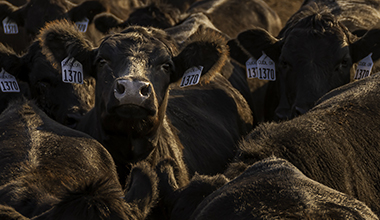Cattle updates
Fed cattle prices surge as does the need for risk protection.
Fed cattle markets have surged, with feeder steer prices reaching new highs. In Montana, on March 21, feeder steers were priced above $3.01 per lb, nearly $0.30 higher than a year ago and up $0.05 per lb from the previous week. Similar trends were seen in all western states. In California, Idaho, Oregon and Washington, feeder steer prices exceeded $2.88 per lb, reflecting year-over-year gains of more than $0.20 and monthly increases of $0.10 per lb. In Arizona, feeder steer prices were slightly lower than last year at $2.82 per lb but still saw a $0.15 increase over the past month. Despite these strong cash market prices, live and feeder cattle futures have started to retreat from record highs reached in mid-March, with all contracts after April turning bearish. This is not surprising as seasonally, cattle prices typically dip during the summer months, before rising again in the last quarter of the year.
While the seasonal adjustment is not a surprise, this shift in the futures market could pose challenges for the cattle industry as cattle purchased at today’s record prices may have to be sold at lower prices. Breeding stock prices have surged, with replacement heifers reaching up to $2,800 and bred cows exceeding $3,500, raising concerns about producers’ ability to sell calves profitably. Producers will need to be able to sell these animals that they purchased at record prices at a profit. The key factor for maintaining strong beef prices is resilient consumer demand. If demand falters, it could have significant negative impacts on the market. That said, the outlook remains optimistic with grilling season approaching, a time when beef demand traditionally peaks. Additionally, strong sales in 2024, which reached a record $104.6 billion, a 5% year-over-year increase, suggest that beef demand has the potential to remain robust.
Packers are grappling with significant challenges as low utilization levels and elevated cattle costs continue to strain operating margins. Packing plant utilization rates are currently below 70%, a level that is unsustainable in the long term. Efforts to adjust, such as reducing slaughter levels and eliminating Saturday shifts, have yet to bring utilization to an economically viable level. Projections suggest that U.S. slaughter utilization will only surpass 80% by the end of 2025, leaving the industry in a precarious position. Meanwhile, feeder cattle prices have added further pressure to packers. This combination of low utilization and high cattle costs is expected to drive continued industry consolidation to an already highly consolidated industry. This places older, underutilized plants at particular risk of closure.
Profitability
March 12, 2025
Cattle feeders: Profitable - Bearish 12-month outlook
Cow-calf producers: Profitable - Neutral 12-month outlook
As feedlots grapple with tightening cattle supplies, competition may continue to ratchet the cost of feeder cattle higher. This could offset the financial benefit of lower feed costs.
Low national cattle inventories continue to bolster cow-calf profitability. However, already tight packer margins could weigh on cattle prices if rising beef prices outpace consumer demand.
